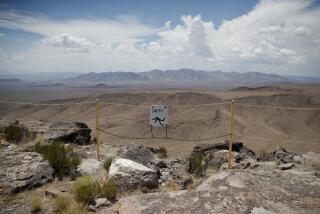It Could Rise From the Grave
- Share via
NIMBY is short for Not In My Back Yard, and nothing on this planet is more NIMBY than nuclear waste. Does NIMBY explain an injunction, issued last Tuesday by U.S District Judge John Garrett Penn, barring indefinitely the opening of a nuclear waste repository near Carlsbad, N.M.? In part, of course, but by no means entirely.
Built by the Department of Energy at a cost of $1 billion, the Waste Isolation Pilot Plant (WIPP) consists of a series of huge chambers carved in an ancient salt deposit a third of a mile below ground level. Intended for deposit there are plutonium-contaminated tools and clothing and other radioactive materials now stored, by default, at DOE weapons plants.
Something, obviously, has to be done with this stuff. Unfortunately, release of the buried plutonium into the atmosphere--even its explosive release--is far from impossible. It could come about by accident as oil or gas drillers penetrated through the repository into high-pressure brine deposits lying below it. It could also come about by an unforeseeable nuclear reaction. Plutonium remains lethal for 250,000 years. In that much time, a lot can happen.
WIPP has been stopped on a legal technicality by New Mexico, Texas and several environmental groups. It may yet go into service, but the better solution is to take seriously the transmutation option offered by such promising research ventures as the Integral Fast Reactor at the Argonne National Laboratory. Changing the waste instead of (or before) burying it involves research and thus delay--but better a good answer later than an irreversibly bad answer now.
More to Read
Sign up for Essential California
The most important California stories and recommendations in your inbox every morning.
You may occasionally receive promotional content from the Los Angeles Times.













